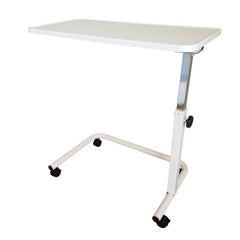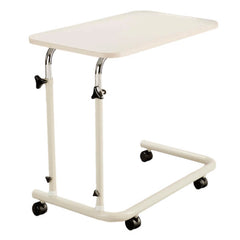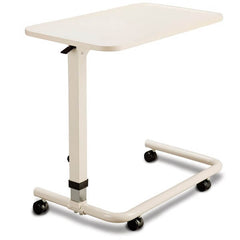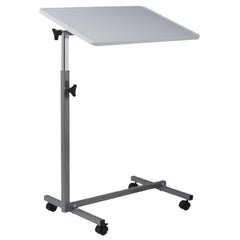Best Over Bed Tables
Ever been stuck in bed longer than you'd like? Maybe it was after surgery, or just one of those lazy Sunday mornings that stretched into the afternoon. Either way, you probably reached that moment where you wanted to eat, work, or read without awkwardly balancing everything on your lap. That's exactly where overbed tables come in.
These nifty pieces of furniture slide right over your bed, giving you a stable surface without having to get up. They're those rolling tables you've seen in hospitals, but they've evolved into something far more versatile for everyday home use too. Whether you need a medical-grade solution for recovery or just want a convenient way to enjoy breakfast in bed, there's an overbed table designed for exactly that purpose.
Versatile Overbed Tables for Home and Medical Use
When mobility becomes limited, even simple tasks can feel challenging. An overbed table creates a little bubble of independence. For someone recovering from surgery or an elderly person who spends a lot of time in bed, these tables make eating, reading, and taking medication so much more dignified and comfortable.
But honestly, they're not just for medical situations. I've seen people use them as mobile laptop desks while working from home – roll it over the couch for a few hours, then wheel it away when you're done. They're perfect for those of us who like the idea of breakfast in bed without the risk of spilling coffee all over the sheets. Think of them as your portable, adjustable personal space that goes wherever you need it.
Types of Overbed Tables
Not all overbed tables are created equal. Let's break down the main types so you can figure out which one actually matches what you need.
Adjustable and Tilting Overbed Tables
Height adjustability is pretty much the baseline feature you want to look for. Without it, you're stuck with whatever height the table comes at – which might leave you hunching over or reaching up awkwardly.
The real game-changer, though? A tilting tabletop. Think about trying to read a book in bed – without a tilted surface, you're craning your neck down for hours. A table that tilts lets you position things at the perfect angle for your eyes, whether you're reading physical books or scrolling through a tablet. Your neck will thank you.
Rolling Bed Tables (Overbed Tables with Wheels)
The wheels are what make these tables truly functional. Without them, you'd have a stationary surface that's a pain to position correctly. With them, you can easily slide the table in when you need it and push it away when you don't.
But here's something crucial that's easy to overlook: locking wheels. Ever tried using a rolling table that kept... well, rolling? It's incredibly frustrating. Those little wheel locks are essential for stability – especially if you're putting hot drinks or medical supplies on the table. Make sure whatever model you're considering has them.
Split-Top Overbed Tables
These clever designs give you the best of both worlds. Imagine having your laptop at an angle for comfortable typing, while your coffee sits perfectly level on another section of the table. That's exactly what a split-top table offers.
Usually, one section tilts for your book or device, while a smaller section stays flat for things that definitely shouldn't tilt (like that morning cup of coffee). It's like having two tables in one, which makes them incredibly practical for multitasking.
Overbed Tables with Storage
If you're someone who accumulates stuff around you – remotes, chargers, medications, pens – then consider a table with built-in storage. These models include drawers or small shelves underneath the tabletop where you can keep essentials within reach but off your main work surface.
This feature is especially valuable in smaller spaces like hospital rooms or studio apartments, where extra storage is always welcome. It helps keep your actual tabletop clear for whatever you're currently doing.
How to Choose the Right Bed Table
Finding the perfect overbed table means thinking about where and how you'll use it. Let's look at what really matters when you're making this decision.
Base Design and Bed Compatibility
The base of your table determines whether it will actually work with your bed. The most common design is C-shaped – picture a letter C where the open part slides under your bed and the vertical part holds up the table.
Before you buy anything, grab a measuring tape. You need to know two things: how high your bed is (including the mattress) and how much clearance you have underneath. Some modern beds sit very low to the ground, which might require a special low-profile base. There's nothing more frustrating than getting a new table delivered only to discover it won't fit under your bed.
Tabletop Materials and Features
The material of your tabletop affects both how it looks and how it functions. In medical settings, you'll typically see high-pressure laminate (HPL) tops because they can be wiped clean easily and stand up to disinfectants.
For home use, you might prefer something with a wood finish that blends better with your decor. But regardless of the material, look for a raised edge around the perimeter. This simple lip can prevent your phone from sliding off when the table is tilted, or contain small spills before they become big problems.
Weight Capacity and Adjustment Mechanism
Think honestly about what you'll be putting on this table. If it's just for meals and a book, standard capacity is fine. But if you're planning to load it up with a laptop, external monitor, and other equipment, you'll need something sturdier.
And pay attention to how the height adjusts. Some tables use a simple knob that you twist to lock the table at different heights. Others have a gas spring mechanism that lets you adjust with one hand. The gas spring is definitely smoother, but it might come with a higher price tag. Consider how often you'll be adjusting the height to decide if it's worth the upgrade.
So there you have it – a complete rundown of what to look for in an overbed table. Whether you need one for recovery, convenience, or just because you deserve the luxury of not having to get out of bed sometimes, the right table is out there waiting for you.
Frequently Asked Questions
How much weight can an overbed table hold?
It really depends on the model you choose. Standard tables typically support between 10 to 25 kilograms – enough for meals, books, and a laptop. If you need something more heavy-duty, look for bariatric models that can handle 45 kilograms or more.
I've seen people try to use lightweight tables for heavy equipment, and it never ends well. Always check the specifications before you buy, and if in doubt, go for something with a higher weight capacity than you think you'll need.
How do I choose the right overbed table for home care?
Focus on ease of use above all else. The person using the table might have limited strength or mobility, so look for smooth-rolling wheels that lock securely and height adjustment that doesn't require much force.
Measure your bed carefully – both the height and the space underneath. A table that fits properly will make all the difference in daily use. And if the table will be used for reading, that tilting feature isn't just nice to have, it's essential for comfort during long periods of use.
Can I use an overbed table with a recliner or couch?
Absolutely! Many people don't realize this, but C-shaped overbed tables work just as well with recliners and couches as they do with beds. The base slides under the furniture while the table surface extends over your lap.
Just be sure to measure the height of your armrests and the clearance underneath your furniture first. Some recliners might be too low for standard tables, and some couches might have bases that don't allow for the table's feet to slide underneath.
What is the standard size of an overbed table?
There isn't one definitive standard size, but most tabletops range from about 60cm to 80cm wide and 38cm to 45cm deep. That gives you enough space for most activities without making the table unwieldy to move around.
The height range is probably the more important measurement. Most tables adjust from around 70cm at the lowest to 115cm at the highest. This range accommodates everything from low platform beds to tall hospital beds. But again, check the specifications of any table you're considering to make sure it will work for your specific situation.















